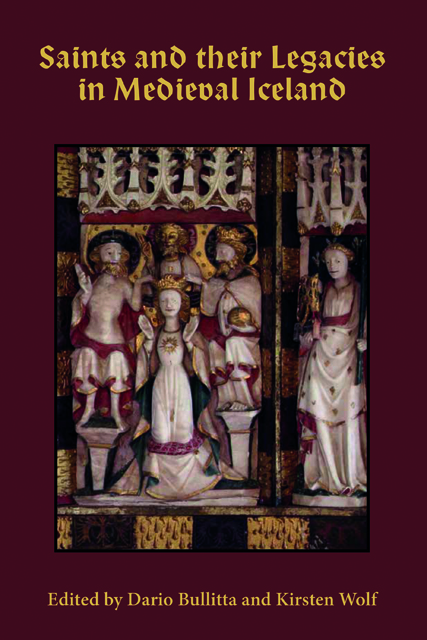Book contents
- Frontmatter
- Contents
- List of Illustrations
- List of Contributors
- Acknowledgments
- List of Abbreviations
- Introduction: The Splendor of the Saints
- Rannsǫkun Heilagra Bóka: The Search for Holy Books
- Heilagir Byskupar: Holy Bishops
- Heilagir Karlar ok Englar: Holy Men and Angels
- Heilagar Meyjar: Holy Maidens
- Bibliography
- Index of Manuscripts
- General Index
- Studies in Old Norse Literature
6 - Lárentíuss saga byskups: Between History and Historiography
Published online by Cambridge University Press: 14 January 2023
- Frontmatter
- Contents
- List of Illustrations
- List of Contributors
- Acknowledgments
- List of Abbreviations
- Introduction: The Splendor of the Saints
- Rannsǫkun Heilagra Bóka: The Search for Holy Books
- Heilagir Byskupar: Holy Bishops
- Heilagir Karlar ok Englar: Holy Men and Angels
- Heilagar Meyjar: Holy Maidens
- Bibliography
- Index of Manuscripts
- General Index
- Studies in Old Norse Literature
Summary
The division of the Old Norse-Icelandic corpus into genres and subgenres is commonplace in literary histories and handbooks. Scholars have long discussed whether or not the Old Norse-Icelandic sagas should be classified according to specific genres, and the feasibility and heuristic usefulness of such classification have been questioned on numerous occasions. The task of identifying certain criteria of distinction and classification is particularly difficult when texts or groups of texts make use of similar topoi and patterns, although they narrate the stories of different social actors. There are several cases in saga literature of authors following conventional hagiographical narrative patterns in their descriptions and glorifications of the life of a political or religious leader. However, the social status shared by the protagonists, such as kings, chieftains, and bishops, of a specific group of sagas does not necessarily imply that consistent use of the same narrative patterns are made in the descriptions of them.
In light of these considerations, it is evident that the byskupa sǫgur do not constitute a homogeneous corpus, and it is hard to argue that they form a specific literary genre or subgenre per se within the field of Old Norse-Icelandic literature. As a matter of fact, they do not seem to form a literary genre or subgenre of Old Norse-Icelandic literature. While the byskupa sǫgur differ significantly from each other in terms of style and the organization of the plot, they often make use of the same stylistic traits and narrative devices that are typical of works belonging to different saga genres or subgenres, such as heilagra manna sǫgur, konunga sǫgur, and Sturlunga saga. As demonstrated below, the liminal position and heterogeneity of the byskupa sǫgur corpus are a result of the diverse social and cultural standing of the protagonists and the divergent narrative strategies adopted by the authors to recount their biographies.
As religious and political leaders, the bishops exercized great influence on different areas of society. Consequently, their lives could be narrated according to equally diverse agendas and ideological frameworks. Moreover, although only three of them – Jón Ǫgmundarson, Þorlákr Þórhallsson, and Guðmundr Arason – were formally recognized as saints by the Roman Catholic Church, the authors of the byskupa sǫgur were inspired also by those bishops who were not canonized but were nonetheless portrayed as living examples of Christian virtues through the use of hagiographical motifs and patterns.
- Type
- Chapter
- Information
- Saints and their Legacies in Medieval Iceland , pp. 159 - 174Publisher: Boydell & BrewerPrint publication year: 2021



